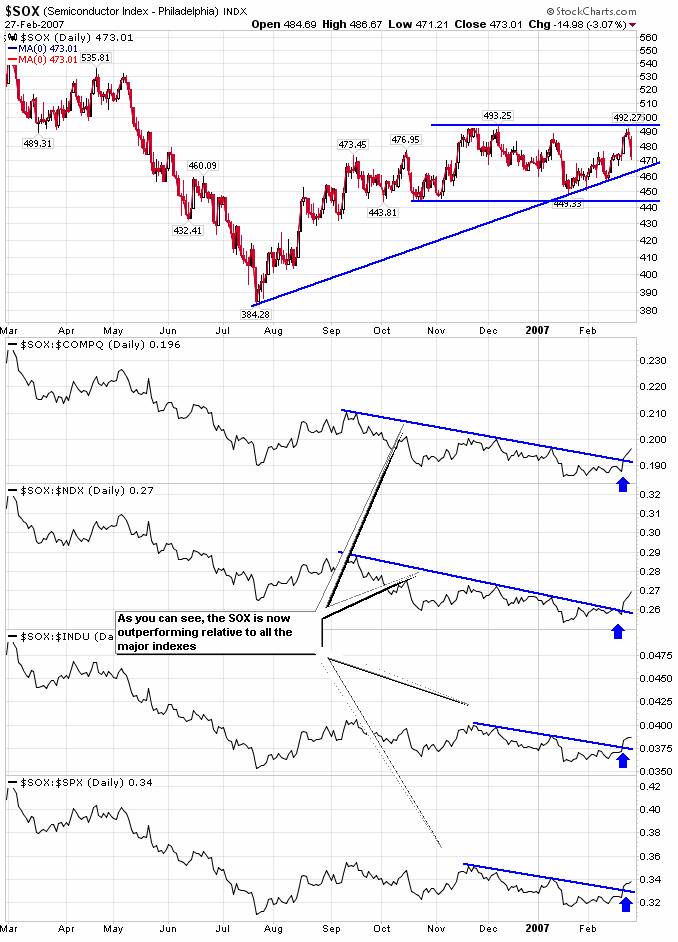Stock Market Falls - What to do now ?
Stock-Markets / Forecasts & Technical Analysis Mar 02, 2007 - 12:53 PM GMTBy: Hans_Wagner
On Tuesday February 27, 2006, the market once again told everyone that it is in charge with a 3.3% drop in the DJIA. When the market makes a move like it did, the first thing to do is step back and assess your situation. History shows us that significant drops in the market are not the start of a new bear market. There are exceptions; however, we are looking at the probabilities. As a result I do not believe this is a bear market. At least not yet. Days like today are often followed by further declines. Most times falls like this, present buying opportunities over the next few days, sometimes up to weeks.
This fall was caused by several factors including:
Chinese authorities seeking to control the speculation in the Shanghai Stock Market. The stated they were considering requiring the equivalent of stricter margin requirements when buying stock. It was up 13% in the last week or so.
-
Glitches in the hybrid trading system used on the New York Stock Exchange. It was more difficult to get a sell limit order executed in the afternoon.
-
Problems with calculating the DJIA when it fell 200 points in the matter of minutes. Caused more panic.
-
Concern that the impact of sub-prime mortgages in the U.S. will cause further problems in the U.S. financial system.
-
Concern that Alan Greenspan called for a possible recession at the end of 2007, even though he made the statement last week. And all he said was that if certain things were to happen in the economy we might see a recession.
-
Concern that the global economy was slowing down faster than people once thought. So far China, India and the other emerging economies are growing and show little signs of slowing down. This does show investors and traders recognize we are now in a global economy.
If you are an investor, not a day trader, here are my thoughts on what to do now:
- If you hold a lot of long positions, then be sure your stops are in place. Evaluate your positions to see where their support levels are and if you want to close out your position if this support fails.
- Make a list of stocks you want to own once the market turns back up. Identify entry levels. I am working hard on updating my watch list right now.
- Monitor the market activity and down turn signals that you use to tell if the market is turning, just in case the probabilities are wrong this time. By the way all my indicators do not show a down turn yet.
- Wait to enter new positions until the selling frenzy has ended the market looks to be holding its position.
- Watch for potential shorting opportunities if they present themselves, keeping in mind that this is not a trend reversal, so the trades will be quick, 1-5 days.
I am glad I have been holding in cash as this makes the down turn easier to handle. It also provides fuel for good buying opportunities.
By the way, I thought this chart was interesting. It is from Breakpointtrades.com. After the market closed for 2/27/07, it shows the SOX (Semiconductor index) in relation to the NASDAQ, DJIA, NDX and the S&P 500. It shows the SOX is starting to outperform these indexes. This can be a good sign for the market, as the SOX tends to lead the NASDAQ which tends to lead the overall market. Just something to keep in mind as the week unwinds.

by Hans Wagner
tradingonlinemarkets.com
My Name is Hans Wagner and as a long time investor, I was fortunate to retire at 55. I believe you can employ simple investment principles to find and evaluate companies before committing one's hard earned money. Recently, after my children and their friends graduated from college, I found my self helping them to learn about the stock market and investing in stocks. As a result I created a website that provides a growing set of information on many investing topics along with sample portfolios that consistently beat the market at http://www.tradingonlinemarkets.com/
© 2005-2022 http://www.MarketOracle.co.uk - The Market Oracle is a FREE Daily Financial Markets Analysis & Forecasting online publication.



